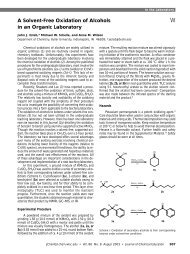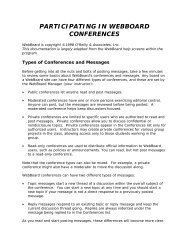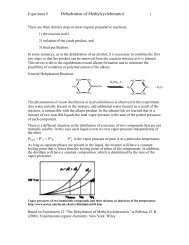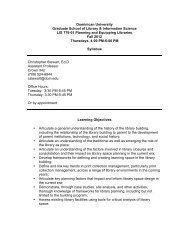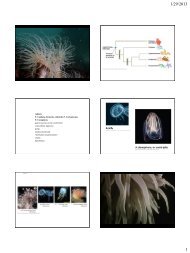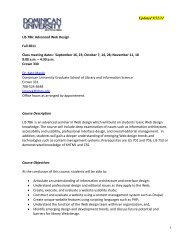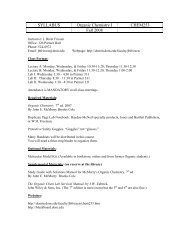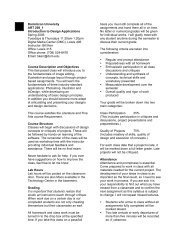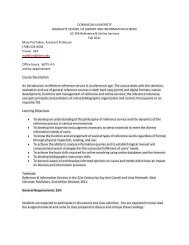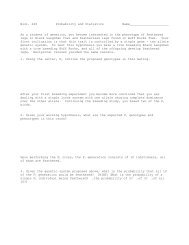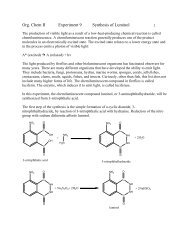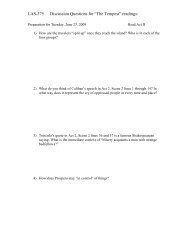Dehydration of Methylcyclohexanol
Dehydration of Methylcyclohexanol
Dehydration of Methylcyclohexanol
You also want an ePaper? Increase the reach of your titles
YUMPU automatically turns print PDFs into web optimized ePapers that Google loves.
Experiment 9 <strong>Dehydration</strong> <strong>of</strong> <strong>Methylcyclohexanol</strong> 1<br />
Prelab Worksheet:<br />
What is the purpose <strong>of</strong> this experiment?<br />
Physical constants.<br />
Name Formula M.W. g/mole m.p. o C b.p. o C Density g/mL<br />
4-methyl-1-<br />
Cyclohexanol<br />
Aldrich #153095<br />
Concentrated (14.7 M)<br />
Phosphoric Acid<br />
Aldrich #695017<br />
85 wt. % in water<br />
5% Sodium<br />
Bicarbonate<br />
Saturated Aqueous<br />
NaCl 32.5% w/v<br />
Magnesium<br />
Sulfate<br />
C 7 H 14 O 114.19 -41 171-173 0.914<br />
H 3 PO 4 98.0 21 158 1.685<br />
NaHCO 3 84.0 ~0 ~100 ~1.0<br />
NaCl 58.44 ~ -10 ~100 ~1.2<br />
MgSO 4 120.4<br />
Name Solubility Safety Information<br />
Methyl<br />
Slightly miscible with water; Flammable<br />
cyclohexanol miscible with alcohols and Irritating to eyes, nose, throat and skin.<br />
Concentrated<br />
Phosphoric Acid<br />
5%<br />
Sodium<br />
Bicarbonate<br />
Saturated Aqueous<br />
NaCl<br />
32.5% w/v<br />
Magnesium<br />
Sulfate<br />
nonpolar solvents<br />
Soluble in water and alcohol.<br />
Insoluble in non-polar solvents<br />
sol in water 100g/L,<br />
some sol in alc,<br />
insol in nonpolar solvents<br />
sol in water 32.5% w/v,<br />
insol in alc,<br />
insol in nonpolar solvents<br />
sol in water,<br />
some sol in alc,<br />
insol in nonpolar solvents<br />
Corrosive. Moderately toxic by ingestion<br />
and skin contact. A severe eye and skin<br />
irritant and a systemic irritant by inhalation.<br />
safe. Weak base.<br />
salty<br />
Moderately toxic. Irritating dust<br />
References:<br />
1) Merck Index, 11th ed.<br />
2) www.chemfinder.com<br />
3) Hazardous Chemical Desk Reference, Lewis and Sax, 1987<br />
4) Aldrich catalog online<br />
5) Phosphoric Acid MSDS http://www.jtbaker.com/msds/englishhtml/p3973.htm<br />
6) aqueous NaCl http://www.vwrsp.com/msds/10/RC7/RC7219.5-1.pdf
Experiment 9 <strong>Dehydration</strong> <strong>of</strong> <strong>Methylcyclohexanol</strong> 2<br />
I. The reaction equation:<br />
1) Write the reaction equation?<br />
2) Calculate the number <strong>of</strong> moles <strong>of</strong> methylcyclohexanol and phosphoric acid.<br />
3) What is the limiting reagent? Keep in mind that phosphoric acid is a catalyst and not a<br />
reactant.<br />
4) What is the theoretical yield (in grams) <strong>of</strong> your predicted product?<br />
5) What is the mass <strong>of</strong> water that would be generated by this reaction?<br />
6) What is the atom economy <strong>of</strong> this reaction? Atom economy =<br />
(molecular mass <strong>of</strong> target product x 100%)/(molecular mass <strong>of</strong> the reactants)<br />
Complete the table for your predicted alkene product:<br />
Name Formula M.W. g/mole Refractive<br />
Index (N 20 D)<br />
b.p. o C<br />
Density g/mL<br />
Solubility<br />
Safety Information<br />
Source(s):
Experiment 9 <strong>Dehydration</strong> <strong>of</strong> <strong>Methylcyclohexanol</strong> 3<br />
II. Procedure<br />
1) How is the reaction yield maximized? (Hint: Le Chatelier)<br />
2) At what temperature does the reaction occur?<br />
3) Does the order <strong>of</strong> addition matter? (alcohol acid or acid alcohol)<br />
4) What is in the distillate?<br />
5) What is left behind in the distilling round bottom?
Experiment 9 <strong>Dehydration</strong> <strong>of</strong> <strong>Methylcyclohexanol</strong> 4<br />
III. Side reactions.<br />
1) What do you think are two more possible dehydration products?<br />
2) Complete the table for your predicted alkene product:<br />
www.acros.com is a good place to look.<br />
Name Formula M.W. g/mole Refractive<br />
Index (N 20 D)<br />
b.p. o C<br />
Density g/mL<br />
Solubility<br />
Safety Information<br />
3) What is one other possible side product?
Experiment 9 <strong>Dehydration</strong> <strong>of</strong> <strong>Methylcyclohexanol</strong> 5<br />
IV. Work-up<br />
1) Look back at II 1) in this handout. What are the two roles <strong>of</strong> hydrodistillation?<br />
2) Look back at II. 4) in this handout. How does the liquid-liquid extraction help to purify<br />
the alkene product?<br />
3) Why add the base NaHCO 3 to the aqueous phase in the liquid-liquid extraction C. 3. in<br />
the procedure?<br />
4) What is the role <strong>of</strong> MgSO 4 or Na 2 SO 4 in C. 7. in the procedure?<br />
5) What are two ways that product is could be “lost” in this workup?
Experiment 9 <strong>Dehydration</strong> <strong>of</strong> <strong>Methylcyclohexanol</strong> 6<br />
V. Devise a flowchart (not a list!) for this reaction.



